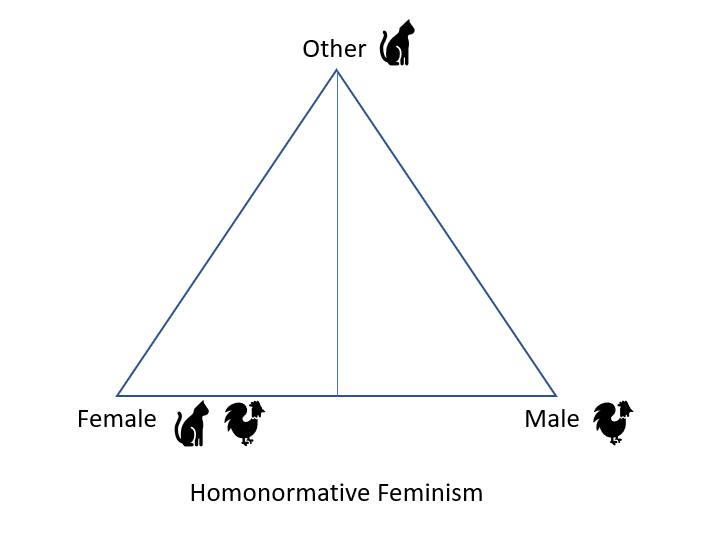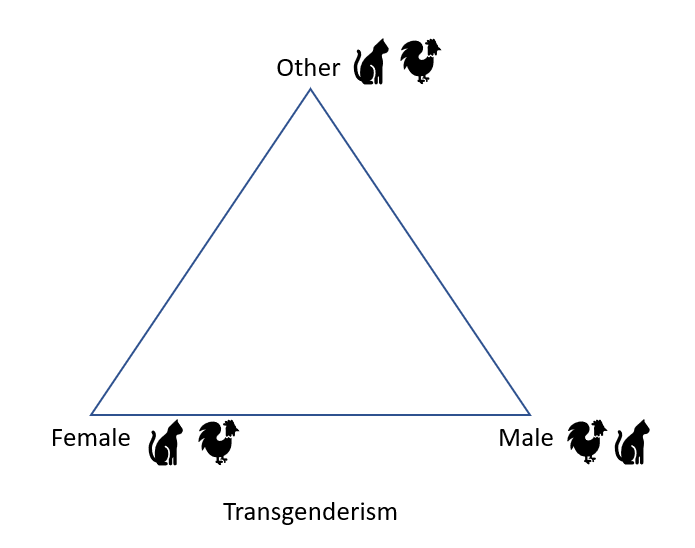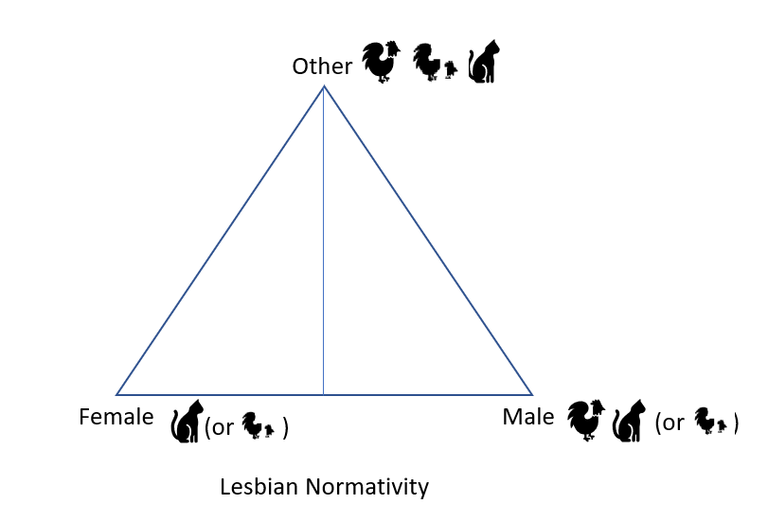(Originally published 28 December 2017)
WARNING: Explicit discussion of reproductive anatomy and activity ahead.
First, the characters:
The Male Body (aka, the Penis, the Phallus, the One)
The Female Body (aka, the Vagina, the Womb, the Zero)
The Big Other (aka, Gender, Sexuation, God)
To echo what has been said over and over again by femme thinkers (Judith Butler, for example), the aggression of the phallus has reached the ocean of stars. The lightsaber that survives the implosion of its binary antagonism, the Elder Wand that persists in the permanent houses of Slytherin and Gryffindor, the Trump that cannot be brought down by his own flaunting of guilt — in all of its manifestations, the phallus has bypassed feminist logic to inscribe itself into the heart of feminism. Equality between the sexes is reached, in these nightmares, by the integration of the -male into the fe-; strap-on egalitarianism where the sacred vaginal Other erupts with “empowered” women wielding phallic power of their own shouting “We’ve all got cocks now!”
This may be an evolution of feminist thinking, but it’s really a radical phallocentrism, a Diet Patriarchy (“Trust us, it’s healthier!”). It doesn’t actually delete the binary antagonism, it just reorients us from heteronormativity to homonormativity, and a particularly-male homonormativity at that. We might be able to argue that it is progress, but we could never imagine such a move as victory over Patriarchy.
So what is left to overcome the male-ification of the female? When the oceanic oneness of the Woman becomes a Zero filled with virtual phallic Ones, hasn’t the operation of feminist logic proven itself to be cannibalistic, consuming maleness only to reify it as fe-maleness? The standard answer to such a failure might be Transgenderism, the supposed collapse of the binary of male and female, a collapse intended to free all bodies and identities from the oppressive disfigurations of heteronormative and cisgender hegemony. The binary itself, in Transgenderism, becomes the site of Absolute Gender, the place where maleness and femaleness dissolve into a true oceanic oneness: no borders or boundaries, no reification of the phallus as necessary to gender expression. Gender becomes a stem cell, a way of applying mysterious sexual energies to a wider web of desires, filling the cosmos with the amniotic fluid of generative potential.
But is this not simply another step of progress, and not the ultimate victory we seek? We recognize that the virtual phallus is not necessary, that our emptiness is intrinsic, normative, that the Big Other — the Phallus of metaphysics, of hegemonic verticalisms and exploitative metanarratives of all kinds, of racism, sexism, classism, speciesism and all the other isms — does not exist, is a lie, a virtual projected phallus.
But Slavoj Zizek tells a joke that might be useful here. A panicked man is running from a chicken, and he seeks psychiatric help for his delusion: He believes he is a grain of corn, and so the chicken desires to eat him. After a long period of therapy the patient overcomes his belief that he is a piece of corn. His doctor declares him mentally healthy and discharges him from psychiatric care. The patient leaves, but soon returns, as scared as ever.
“What’s wrong?” his doctor asks, “Don’t you know that you are not a piece of corn?”
“Yes, I know it,” says the man, “but does the chicken know it?”
Transgenderism brings to our consciousness a transgressive and therapeutic knowledge: we are no longer ruled by the delusion that there is a structuring power to the universe that tells us ahead of time who we are. But it only heals us of the symptom of our struggle, it only implodes and obliterates the false Law (Patriarchal, cisgendered heteronormativity) that can never give us the egalitarian utopia we seek. And in that symptom-satiating service it is healthy, the way quitting an addiction is healthy.
What Transgenderism does not do, however, is heal the chicken of its delusion; it can never stop the enemy from being an enemy, even if we stop believing in it as an enemy. The Other remains stained by our pathology, and we are helpless against that stain. All of our will-to-power, our transgression beyond the binary, our acceptance of the Zero-level, generative potential of all things — of the patient and the chicken — produces either masculinist reification of the phallus in strap-on feminism or frozen fear amidst the chaos of the Other’s will-to-power. The ocean of equals that contains me as a free Subject, a full Agent in control of my identity and destiny, also contains the ghost of an “Other” that is likewise free: free to attack me, free to run away, and therefore free to be a mystery and a threat.
Fake the phallus or dissipate into the ocean: flip the binary so that Femaleness becomes the new hegemonic principal governing a strap-on homonormativity, or languish in the terror of pure Transgenderism, of Queer Normativity where the stem cell of Gender is free to wield any wild energies it latches onto.
Religious technologies — prayers and liturgies and calendars and offices and social dogmas and mythologies — create two movements: a vertical and a horizontal, a Yin and a Yang, a that and a this, events and interpretations, texts and hermeneutics, immanent and transcendent, common and sacred. So if you wanted to design an approach to feminism or to gender theory or a philosophy of sexuation based on religious technology, you would set out to demarcate and trace how gender operates in relation to these technologies, how they intersect and influence each other. Such theories were operative long before anyone thought up names like heteronormativity or genderqueer, and religious technologies typically shaped gender identities into strict sexual-somatic symmetry organized around an imperial Patriarch of a Big Other: a God-the-Father. The hyper-relation between religious (particularly Abrahamic) technology and sexuation is universally criticized as the fountain of oppression from which non-males and non-straight people have to liberate themselves. To return to religion as a source of liberation is therefore counterintuitive (or at least potentially traumatic) for Queer, Femme, and Womanist people.
The problem is that neither of the approaches discussed above, homonormative feminism or Transgenderism, achieve a Female body rooted in equality and flourishing into utopian fullness. Transgenderism secures an egalitarian horizon without offering a vision for the future, a utopia beyond that horizon; homonormative feminism offers a new utopia that operates by the same verticalist oppressive logic as heteronormative patriarchy, a world where the power of the fraudulent phallus is uncheckable, a sea of dildos.
So what does a better feminist religion look like? How can these religious technologies be deployed in ways that express 1) the lack inherent to gender itself (that is, a religion that is self-consciously within egalitarian transgendered social relations) and 2) the utopian vision of a future without the binary antagonism, without fake phalluses dominating and consuming each other?
Solutions
“If male bodies could be cut somehow, if the phallus could be wounded from the outset, we could perhaps find a new solidarity, a new egalitarian power born out of vulnerable humility, female openness to the horizontal path that leads through the narrow gate.”
Consider the universal equality that is the hallmark of Transgenderism: everyone, sexually, is a Zero, an empty womb space of creative gender-energy. Now consider the utopia of homonormative feminism: everyone is vulnerable and marked by a wound, but the woman can wield the One, the power of the man, without succumbing to his oppressive nature (strap-on phallocentrism, Diet Patriarchy).
Put another way, everyone is a sexual “Fe-” that can be attached to a cancer as much as a cock, meaning gender identities are not stable or fixed, but fluid. Unfortunately, that fluid freezes the moment it is released into the vacuum of Absolute Gender Space; it is vulnerable not only to outside phallic forces (heteronormative Patriarchy or homonormative Feminism), but also internal insufficiency (“But does the chicken know it?”). The image of the Vagina as both a generative womb and a somatic breach is critical to a feminist religious theory after the failure of phallocentric feminisms of the past and impotent transgenderisms of the present. Vaginal power, not phallic, needs to be strapped-on. Female bodies are already marked by these religious movements of vertical wound and horizontal utopia: a vertical scar leads the horizontal traveler through the narrow gate and into the generative womb space. No strap-on is required for the female to deploy this energy, this specifically-female religious technology. Ladies come pre-equipped for religious affectations, structured to receive higher consciousness as a gift, structured to generate Life.
Male bodies, however, are marked by the Law of the phallus, the wound-making technology that is simultaneously required for life to continue and demanding that blood be spilt. “Only death can pay for life” says the sorceress of blood magic in Game of Thrones, and the saying is true for the Law of the phallus, drawing blood when it pierces the Vagina to create a new life doomed to die. How, therefore, can we overcome this Law of the phallus that leads to blood and death? How can we show that the phallus can never give the seed of eternal life to the generative uterine space of the woman?
Can we go so far as to mark the Penis at birth?
Can we use our religious technology, our vertical and horizontal movements, to cut the maleness away from male bodies?
If only there was some ritual that could graft the stem cell of “Fe-” onto males, that could wound the Law of the phallus with its own symbolic vertical death. Such a wound could, perhaps, become a breach, an opening to generative potential as well as a picket-line banner to this body’s permanent vulnerability.
If male bodies could be cut somehow, if the phallus could be wounded from the outset, we could perhaps find a new solidarity, a new egalitarian power born out of vulnerable humility, female openness to the horizontal path that leads through the narrow gate. We could acknowledge the primordial woundedness of our fellow sisters and brothers, marked as we all are by the rupture that instills us with creative potential. Thus, contrary to homonormative feminism where the binary of power is flipped and females wield a virtual phallus amidst an ocean of phallic subjects, this male cutting ritual, this anti-phallocentricity, locates feminism (or female-ness) as the site of egalitarian solidarity, an artificial condition created by religious technology that unites all people into wounded womanhood, regardless of body type.
One of the early Christian Gnostics — mystics who overlapped Christianity with popular philosophies — wrote that Jesus instructed women to become men. “Jesus said: Look, I will lead her that I may make her male, in order that she too may become a living spirit resembling you males. For every woman who makes herself male will enter into the kingdom of heaven” (Gospel of Thomas 114). Though there were certainly other reasons for excluding this Gospel from the Christian New Testament, this annihilation of womanhood could not be a more clear example of heretical thinking. The authentic Gospel of Jesus is precisely the inverse of this proto-homonormative feminism, this ascent of the phallus into the ocean of the divine. Instead, what Jesus preaches is much closer to a lesbian heteronormativity, a world of vaginas opening themselves to themselves and to each other, a world where the aggressive energy of the phallus is cut off from the outset and the full, unaltered Penis — the mark of the totally-free Subject, the only One who is a true Full Agent — is reserved by the Other. The chicken from the joke, the Other who remains a mystery and a threat, is now revealed as a, or the, Cock. The Other loses a hint of its mystery because we know something about it: it is not like us, it transcends us somehow, but within a vertical, phallic logic that we can identify and relate to. The Cock will be a violent presence either way, but since it remains hidden as the Big Other, my relation to it is ultimately related to Will or to Grace, to works of righteousness or to a gift of faith, to a cockless attempt at life from an empty womb or to an open door ready to receive the Divine Wand.
The question for the entire world of femme bodies — those born female and those marked by a sacred wound to unite them to females — is whether there is a Big Other with real Life to impart to our spiritual Wombs?
Is there a God with a fixed identity, an eternal, unchanging, phallic Law, yet who gives himself as a wounded Man and a Spirit-filled Bride?
The Way of feminism is the way of the Cross: the worship of the One crucified Man, His Father the Lawgiver, and His Spirit who makes us all one Female Body, ready to receive the deposit of Faith.




Hi! I am a robot. I just upvoted you! I found similar content that readers might be interested in:
https://medium.com/@jcb7/notes-for-a-feminist-religion-or-the-gospel-according-to-sex-organs-e3b19c223560